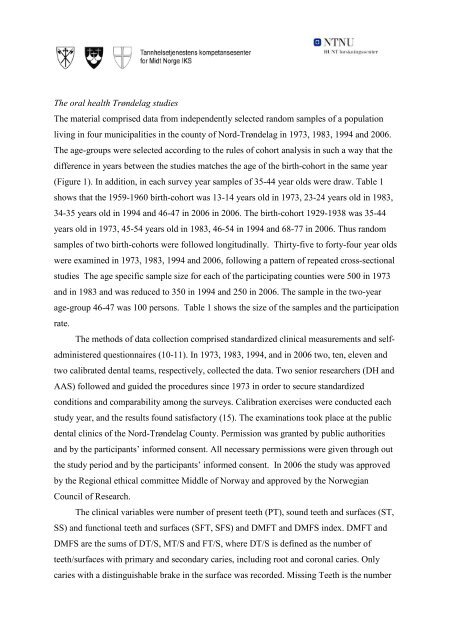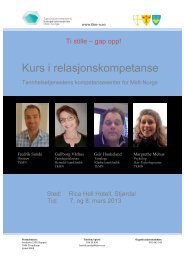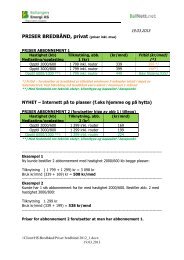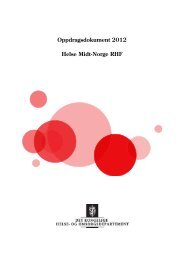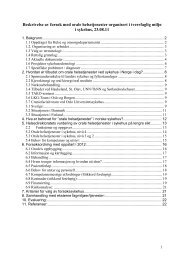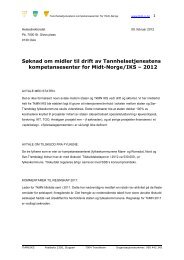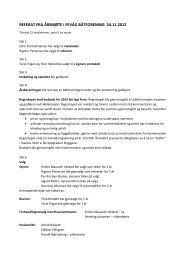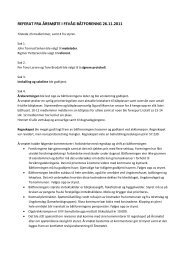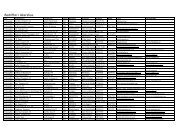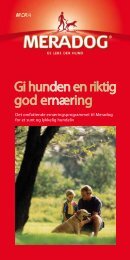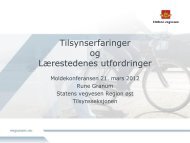Oral Health in Norway. The HUNT Study.
Oral Health in Norway. The HUNT Study.
Oral Health in Norway. The HUNT Study.
Create successful ePaper yourself
Turn your PDF publications into a flip-book with our unique Google optimized e-Paper software.
<strong>The</strong> oral health Trøndelag studies<br />
<strong>The</strong> material comprised data from <strong>in</strong>dependently selected random samples of a population<br />
liv<strong>in</strong>g <strong>in</strong> four municipalities <strong>in</strong> the county of Nord-Trøndelag <strong>in</strong> 1973, 1983, 1994 and 2006.<br />
<strong>The</strong> age-groups were selected accord<strong>in</strong>g to the rules of cohort analysis <strong>in</strong> such a way that the<br />
difference <strong>in</strong> years between the studies matches the age of the birth-cohort <strong>in</strong> the same year<br />
(Figure 1). In addition, <strong>in</strong> each survey year samples of 35-44 year olds were draw. Table 1<br />
shows that the 1959-1960 birth-cohort was 13-14 years old <strong>in</strong> 1973, 23-24 years old <strong>in</strong> 1983,<br />
34-35 years old <strong>in</strong> 1994 and 46-47 <strong>in</strong> 2006 <strong>in</strong> 2006. <strong>The</strong> birth-cohort 1929-1938 was 35-44<br />
years old <strong>in</strong> 1973, 45-54 years old <strong>in</strong> 1983, 46-54 <strong>in</strong> 1994 and 68-77 <strong>in</strong> 2006. Thus random<br />
samples of two birth-cohorts were followed longitud<strong>in</strong>ally. Thirty-five to forty-four year olds<br />
were exam<strong>in</strong>ed <strong>in</strong> 1973, 1983, 1994 and 2006, follow<strong>in</strong>g a pattern of repeated cross-sectional<br />
studies <strong>The</strong> age specific sample size for each of the participat<strong>in</strong>g counties were 500 <strong>in</strong> 1973<br />
and <strong>in</strong> 1983 and was reduced to 350 <strong>in</strong> 1994 and 250 <strong>in</strong> 2006. <strong>The</strong> sample <strong>in</strong> the two-year<br />
age-group 46-47 was 100 persons. Table 1 shows the size of the samples and the participation<br />
rate.<br />
<strong>The</strong> methods of data collection comprised standardized cl<strong>in</strong>ical measurements and selfadm<strong>in</strong>istered<br />
questionnaires (10-11). In 1973, 1983, 1994, and <strong>in</strong> 2006 two, ten, eleven and<br />
two calibrated dental teams, respectively, collected the data. Two senior researchers (DH and<br />
AAS) followed and guided the procedures s<strong>in</strong>ce 1973 <strong>in</strong> order to secure standardized<br />
conditions and comparability among the surveys. Calibration exercises were conducted each<br />
study year, and the results found satisfactory (15). <strong>The</strong> exam<strong>in</strong>ations took place at the public<br />
dental cl<strong>in</strong>ics of the Nord-Trøndelag County. Permission was granted by public authorities<br />
and by the participants’ <strong>in</strong>formed consent. All necessary permissions were given through out<br />
the study period and by the participants’ <strong>in</strong>formed consent. In 2006 the study was approved<br />
by the Regional ethical committee Middle of <strong>Norway</strong> and approved by the Norwegian<br />
Council of Research.<br />
<strong>The</strong> cl<strong>in</strong>ical variables were number of present teeth (PT), sound teeth and surfaces (ST,<br />
SS) and functional teeth and surfaces (SFT, SFS) and DMFT and DMFS <strong>in</strong>dex. DMFT and<br />
DMFS are the sums of DT/S, MT/S and FT/S, where DT/S is def<strong>in</strong>ed as the number of<br />
teeth/surfaces with primary and secondary caries, <strong>in</strong>clud<strong>in</strong>g root and coronal caries. Only<br />
caries with a dist<strong>in</strong>guishable brake <strong>in</strong> the surface was recorded. Miss<strong>in</strong>g Teeth is the number


